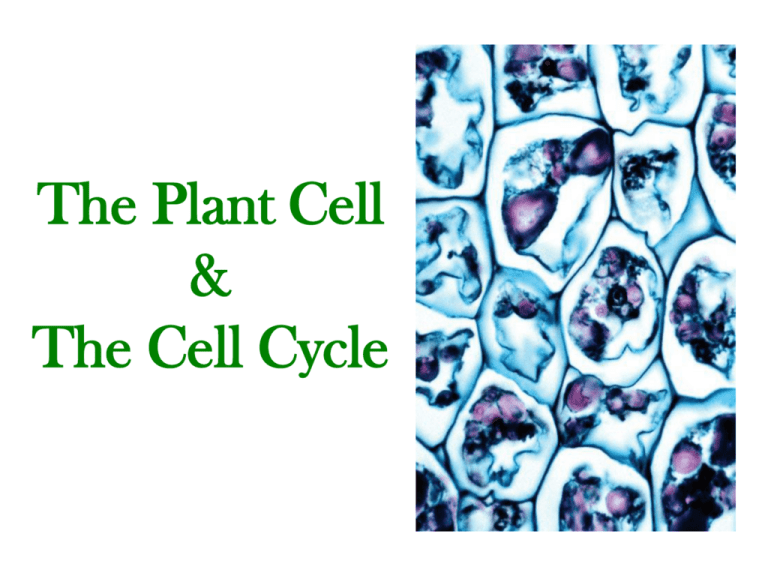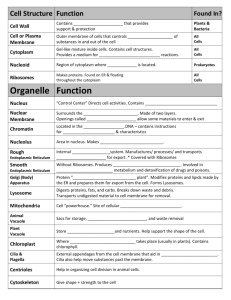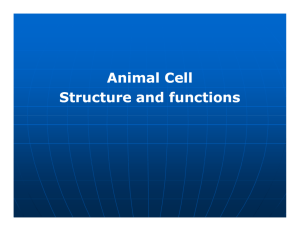CB098-008.35_Plant_Cell_&_Cycle
advertisement

The Plant Cell & The Cell Cycle The Plant Cell Plant cells are the basic units of plant structure and function. Different plant cells have different functions. Labeled below are the organelles within a plant cell. The Boundary Between Inside & Outside Plasma Membrane – controls movement of material into and out of the cell. Plasma membrane, a.k.a. cell membrane surrounds each cell. The membrane is made of a phospholipid bilayer with imbedded proteins. The membrane is selectively permeable (controls what goes through and some items travel through easily while others travel slowly and others are totally blocked). Plasmodesmata - An open channel in the cell walls of plant cells allowing for connections between the cytoplasm of adjacent cells. This is a connection of tubes that allows two plant cells to be joined (Joins cells together). 2 Plant Cells Cytoplasm Cell Wall This continuous cytoplasm in a set of cells connected by plasmodesmata is called symplast. Cell Wall - Limits cell expansion; rigid structure outside the plasma membrane. It is made of microfibrils (small fibers) formed from a polysaccharide, cellulose. Cellulose Fibers of a Plant Cell Wall Osmosis and Turgor Pressure Osmosis - the flow of water from a relatively dilute solution to a more concentrated solution across a selectively permeable membrane. Protoplast – the organized living unit of a single cell. Turgor Pressure – the pressure within a cell resulting from the osmotically generated imbibition (absorption of water) of water into the protoplasm and vacuole. In plants, a large turgor pressure can result and greatly support plants. Turgid – means firm. Plant cells are swollen or turgid when they absorb water. Plasmolysis – the separation of the cytoplasm from the cell wall caused by a removal of water from the protoplast. The cell wall on the outside of the cell is rigid and the plasma (cell) membrane can grow or shrink based on water pressure. The plasma membrane grows in size with the influx of water but cell wall limits the plasma membrane’s growth and eventually balances the pressure of osmosis “stopping” the flow of water into the cell. When water is cut off, a leaf wilts. “This occurs because water is lost from the cell and turgor pressure decreases. Osmosis can work in and out of cells. CELLS SOLUTIONS Around Cells In this first row, concentrations are balanced between in and out of the cell. Water is not moving in or out. Isotonic Solution – equal concentrations of solute in & out of cell. In this row, concentration is greater in the cell. Water will move into the cell until concentrations are balanced or until cell wall limits the size of the plasma membrane. Hypotonic Solution – lower concentration of solute. In this row, concentration is lower in the cell. Water will move out of the cell until concentrations are balanced. Protoplast will shrink away from the cell wall and PLASMOLYSIS results. Hypertonic Solution – greater concentration of solute. A plasmolyzed cell has no turgor pressure. Thus, an accumulation of salt in a soil can cause a plant to wilt. Normal Plasmolyzed Elodea Elodea Cells Cells Osmosis and Turgor Pressure Primary Cell Wall forms when a cell is still growing. Secondary Cell Wall is between the primary cell wall and the plasma membrane. This forms after the cell stops growing. The secondary cell wall contains cellulose microfibrils and a strong, water-impermeable substance call lignin. Lignin makes the secondary cell wall especially rigid and much more able to resist stretching or compression. Lignin in the secondary wall provides strength for wood. Other specialized cell walls have cutin covering them or suberin embedded in them. Both are waxy compounds. Cutin – cutin cell walls are formed on surface of leaves and other organs exposed to air (protect against water loss and disease.) Suberin – a waxy tissue found in the cell walls of cork tissue. The Organelles of Protein Synthesis & Transport Much of the cell is made of protein. Nucleus -Stores and Expresses Genetic Information (DNA). -Controls the cell’s activities by directing protein synthesis. -Inside the Nucleus, DNA and proteins make up chromosomes. -Nucleus is surrounded by the nuclear membrane (nuclear envelope). -Nucleolus is within the nucleus, where ribosomal RNA (rRNA) is made and assembled with proteins imported from the cytoplasm. Resulting is the ribosomal subunits which will form functional ribosomes when they exit to the cytoplasm of the cell. Ribosomes A ribosome is a cell structure consisting of RNA and protein organized into 2 subunits and functioning as the site of protein synthesis in the cytoplasm. Ribosomes occur on the Endoplasmic Reticulum and Cytoplasm. RNA along with ribosomes carry the genetic information of its DNA template out of the nucleus and into the cytoplasm for protein synthesis. Endoplasmic Reticulum Endoplasmic Reticulum is a membranous system of channels and flattened sacs that traverse the cytoplasm. There are 2 varieties. Rough Endoplasmic Reticulum – This is rough because it has bumps. These bumps are ribosomes. This is the site of protein synthesis. Smooth Endoplasmic Reticulum – Does not have ribosomes so it is smooth. The Smooth E.R is the site of lipid synthesis and it stores calcium. Nucleus Golgi Apparatus The golgi apparatus is a stack of membranous sacs surrounded by vesicles. It stores and ships products from the endoplasmic reticulum. It guides the movement of protein to certain compartments. The Organelles of Energy Metabolism Plastid – A cellular organelle in which carbohydrate metabolism is located. Plastids are double-membraned. Plastids are complex organelles found in every living plant cell. Types of plastids: leukoplasts, amyloplasts, chromoplasts and chloroplasts. Chloroplast and Mitochondria are energy converting organelles in a plant. Chloroplast – the site of photosynthesis. Chloroplasts are found in the green parts of plants. They contain the pigment chlorophyll. Mitochondria Mitochondria is the site of cellular respiration (also named cell respiration, oxidative respiration, and aerobic respiration). Mitochondria make useful forms of chemical energy. ATP generation occurs here. ATP powers many of the important chemical reactions in the cell. Other Organelles Vacuole – The vacuole is often the largest organelle in a plant cell. It is mainly for storage. It is a large compartment. It may bring water into the cell, store nutrients and/or chemicals meant for pigmentation or chemical defense. Another cellular structure is the cytoskeleton, which holds organelles in place and directs their movement. The Cell Cycle (Cell Division) Cells divide in regions called meristems. Meristems – sites in the plant body where cells divide and where differentiation into specialized cells and tissues are initiated. Meristems are found in the tips of roots and shoots and in some other regions of the plant (This will be discussed in later chapters). The Cell Cycle, consisting of the G1, S, G2 and M phases. Approximately 50% of new daughter cells leave the cycle at either G1 or G2 and begin to differentiate; the remaining cells will cycle again in the meristems. Cell Cycle G1 – S – G2 – M – Pre-DNA synthetic Phase Synthesis (Duplication) of DNA Premitosis Phase Mitosis Interphase During mitosis, nuclear division (Karyokinesis) and cytoplasmic division (cytokinesis) occurs. During mitosis, the mother nucleus (2n chromosomes) divides and resulting 2 daughter nuclei have identical number of chromosomes (2n chromosomes each). The main point of mitosis is to separate the DNA and result in 2 nuclei with the same DNA. Mitosis Note the stages and the order of the stages of mitosis: Prophase Metaphase Anaphase Telophase Cytokinesis Chromosomes are condensing. Nuclear membrane is breaking down. Chromosomes are lined up at equatorial plane Chromosomes separate and move to opposite poles Chromosomes begin to uncoil. Nuclear membrane reforms. BIO 141 Botany with Laboratory • This product is sponsored by a grant awarded under the President’s Community-Based Job Training Grants as implemented by the U.S. Department of Labor’s Employment and Training Administration. The information contained in this product was created by a grantee organization and does not necessarily reflect the official position of the U.S. Department of Labor. All references to non-governmental companies or organizations, their services, products, or resources are offered for informational purposes and should not be construed as an endorsement by the Department of Labor. This product is copyrighted by the institution that created it and is intended for individual organizational, non-commercial use only.








